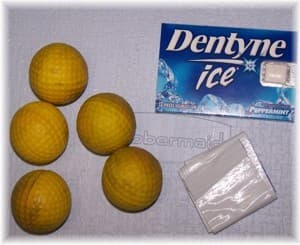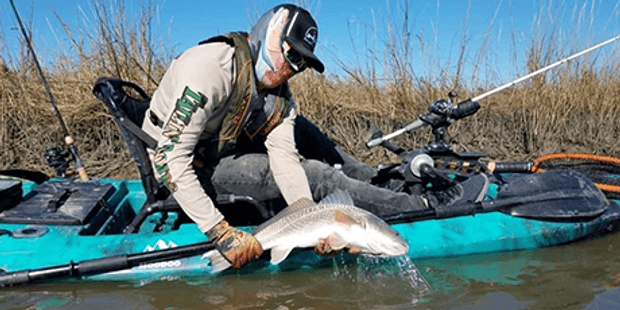There's A Hole In My Boat (Part 1)
Any captain, regardless of the tonnage of his vessel, is concerned with taking on water. Kayaking, and kayak fishing are wet sports. I'm constantly amazed at the number of paddle anglers whose prime concern is staying dry. But we can certainly take some precautions to keep the inside of the boat dry, and hopefully stop a leak before it ever starts. In this installment, we'll talk about prevention and then about emergency repairs. Next month, we'll chat about finding the leak, and repairing it.
Right now, I'm making several assumptions. First, that you paddle the typical sit-on-top roto-molded plastic kayak. Second, that you're admiring this article while sitting in your living room, tossin' back a coolie, and waiting for football season to start. OK, maybe that's just me. But you're certainly not out on the water. So, there's still time to protect you from yourself, so that you don't need to read the rest of this article, or the next one. Too late, you're already reading... Carry on.
ROTO-MOLDED KAYAK MANUFACTURING 101:
Imagine a $40,000 clamshell. That's what made your boat. Back when I was knee deep in the design and manufacturing end of this sport, I was amazed at the "artist meets engineer" aspect of bringing a boat to market. Voodoo is probably involved as well, though I never saw the chicken's foot. But, despite the efforts of all parties concerned, the weakest points of a roto-molded boat will be where the clam shells meet at the outer seam and at the scupper holes. Those joints are affectionately called "the parting lines", because that's where the mold parts upon de-molding (very technical term, eh?). The mold gets blasted up to 500+ degrees, endures its bake cycle, then is cooled in order to get the part out. As it cools, the bare kayak shrinks, and that amount of shrinkage depends on the resin, the cook cycle, the dimensions and geometry of the boat, and to some degree, the size of that chicken's foot. The point here is that there are a number of variables that go into making a great boat. Should any of those variables be out of spec, there *could* be a weakness somewhere in the boat. And, should that happen, chances are that it will happen along that parting line.
~Fishing Kayaks from Hoodoo Sports~
Looking for a high quality fishing kayak at a reasonable price? Check out Hoodoo's lineup featuring the new dual-drive Impulse.
PROTECTING THE PARTING LINE:
Aristotle said, "... We are what we repeatedly do..." Such is the mantra of mass production. Rest assured, your boat went through lots of R & D, as well as trial-error-recovery before it made its way to you. It's a good boat. Still, we need to practice a little common sense when we're out on the water, and do what we can to protect those parting lines.
- No rigid stake out poles through the scupper holes. There are a number of companies that makes these now, and they're gorgeous. Much like a hand made pool cue. But, they're best suited to be used with an anchor trolley, and not used via the scupper hole. Since these stake out poles don't flex, in order to absorb the shock of a wave, the scupper hole plastic must concede. Either it will bend, or it will break. If you're like me, and prefer to stake out that way, continue using a section of PVC pipe. It will bend a bit, and will hopefully take the punch so the scupper doesn't have to.
- Don't sit in the boat unless it's in the water. In the water, your weight is distributed evenly. On land however, the bottom can't flex, and the widest portions of the boat must endure the stress... and those points are normally the parting lines.
STUPID HUMAN TRICKS:
- Don't drag your boat. Use a cart, or a buddy. Plastic is soft, and it doesn't heal on its own.
- Never ride your kayak down snow covered hill. I was playing golf with my brother-in law down in Key Largo a while back. Alongside one of the water features we saw a sign that said "please do not molest the alligators". That's not a common phrase, so I assumed it was posted as a result of an alligator molestation. I tell this tale only because sometimes people do some pretty stupid things. Kayak sledding is one of those things. When it's cold, the plastic is much less flexible. I'd also wager that the stop at the bottom of the hill won't be graceful. These factors could easily result in a crack in the hull. And, that crack won't be evident until spring, when the snow and the memory of this event are both gone.
PREPARATION AND SHORELINE REPAIR:
We all have spares of our favorite lures, carry several rods, or even go as far as to pack a spare paddle. Being prepared is already part of our pre-fishing routine. However, I don't know too many paddlers that are prepared in case their boat springs a leak.
There's a little "McGyver" in all of us. This is my answer to the burning question, "What would McGyver do?" I give you the "hole in my boat" survival kit. Put these in a zip-lok bag and toss it inside your boat. Don't worry about losing it in the bowels of your craft because should you ever need it, just open the hatch and the kit will float to you. The survival kit includes:

- The Force. Darth Vader was right when he spoke of the "force". You remember, light side, dark side, holds the universe together. Who knew he was speaking of duct tape. So get one of those spare tackle tray dividers (and I know you have about 30) and wrap some duct tape around it. Be careful as you wind up the tape because nothing screams poor workmanship quite like a wrinkle in your duct tape.
- Foam practice golf balls. They come in a pack of 6, not sure where the other one is. But make sure you have enough to plug all of your scupper holes. Normally, the parting line in the scupper hole will be above the anticipated water line. So if you push the ball down past that, no water gets up to that parting line. Brilliant.
- Chewing gum. Laugh if you want, but if you have a big hole to repair, a big chaw of gum covered by some duct tape just might get you back to the launch.
SHORELINE LEAK DETECTION:
The first indication that you've taken on a significant amount of water will be a feeling that the boat is heavy, sluggish, and harder to keep straight. And, that sloshing sound will also be a clue. First order of business, get to shore. That's important because paddling that heavy boat will drain your strength quicker than an empty sound boat will.
It's not uncommon for a perfectly good boat to take on water under extreme conditions. Hatches can leak, so can hardware fastened with rivets. All plastic boats exhibit some degree of "oil canning", which simply means when you sit in it, the hull gives way to your weight. It's plastic, it bends. During "oil canning" air gets pushed out of the smallest hole when you sit on your boat. It happens normally by air escaping around hatch covers and rivets, without you even knowing. But, when you get out of the boat air (or water) will get sucked back in the same places. If you're in some rough seas, with waves coming over the bow (and hatch) and standing around hardware rivets, it's quite possible that your paddling movements are enough to cause the boat to "breathe" and thereby inhale some water in the process.
But for now, we're looking for a hole. First thing to do after you get ashore is get the water out. Drain plugs are great for getting lots of water out of a SOT, but since the depth of the plug is normally much deeper than the thickness of the hull, you can never get all the water out. Once the boat is empty, look in the most likely places for that leak.
- Got scratches, scuffs, and dings? Check those to see if any have broke on through to the other side. If yes, dry the wound. Plug with gum, cover with duct tape. Remember what I said about those wrinkles.
- Check the parting lines. You're looking for a pinhole or a slight crack. Find one, gum & tape.
- Since the only thing you can do for the scuppers is plug 'em with the golf balls, plug 'em. Plug 'em all.
With the leak temporarily plugged, time to head to the launch. Hopefully you've been able to notify someone via your radio or cell phone that you've running a wee bit late getting back. Also, I'm hoping that you didn't paddle alone. So, hug the shore when you can, stop and empty the boat again if you need to. Be smart, get back to the launch safely.
In the next article, we'll discuss how to pinpoint where that leak is, and then we'll tackle the repair.
See you out on the water!
"Many men go fishing all of their lives without knowing that it is not fish they are after" ~ Henry David Thoreau
Related Articles
Last month we discussed how to detect and patch (not "repair") a leak on a typical roto-molded kayak…

